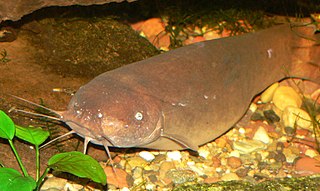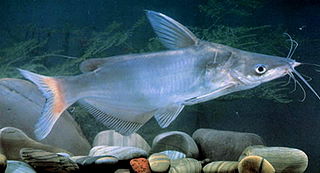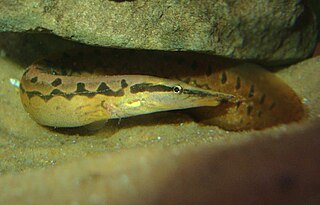
Electric catfish or Malapteruridae is a family of catfishes. This family includes two genera, Malapterurus and Paradoxoglanis, with 21 species. Several species of this family have the ability to produce an electric shock of up to 350 volts using electroplaques of an electric organ. Electric catfish are found in tropical Africa and the Nile River. Electric catfish are usually nocturnal and carnivorous. Some species feed primarily on other fish, incapacitating their prey with electric discharges, but others are generalist bottom foragers, feeding on things like invertebrates, fish eggs, and detritus. The largest can grow to about 1.2 m (4 ft) long, but most species are far smaller.

Clarias is a genus of catfishes of the family Clariidae, the airbreathing catfishes. The name is derived from the Greek chlaros, which means lively, in reference to the ability of the fish to live for a long time out of water.

Sisoridae is a family of catfishes. These Asian catfishes live in fast-moving waters and often have adaptations that allow them to adhere to objects in their habitats. The family includes about 235 species.

Akysis is the largest genus of catfishes of the family Akysidae.

Malapterurus is a genus of catfishes of the electric catfish family (Malapteruridae). It includes 18 species.

Cranoglanis is the only genus of armorhead catfishes.

The zig-zag eel, also known as the tire-track eel, tire-track spiny eel or marbled spiny eel, is a species of ray-finned, spiny eels belonging to the genus Mastacembelus of the family Mastacembelidae, and is native to the riverine fauna of India, Bangladesh, Pakistan, Sri Lanka, Thailand, Viet Nam, Indonesia and other parts of South East Asia. The species was described as Macrognathus armatus by Lacepède in 1800. Other common names for this popular aquarium species are leopard spiny eel and white-spotted spiny eel. This species is not only a popular aquarium fish but also as a food fish in its country of origin.

Bagrichthys is a genus of bagrid catfishes.
Nanobagrus is a genus of bagrid catfishes found in Southeast Asia. All species are quite small fish.
Pseudomystus is a genus of catfishes of the family Bagridae.
Parakysis is a genus of catfishes of the family Akysidae. It includes six species.

Acrochordonichthys is a genus of catfishes of the family Akysidae. It includes ten species.

Microsynodontis is a genus of upside-down catfishes native to freshwater rivers in western Africa. The genus was originally described by British-Belgian zoologist George Albert Boulenger in 1903 based upon the type species Microsynodontis batesii. The name microsynodontis comes from the Greek word mikro, meaning small, and the Greek term synodon, meaning "with the teeth all growing together".
Nanobagrus immaculatus is a species of bagrid catfish endemic to Indonesia where it is found in the Kahayan River drainage of southern Borneo. It grows to a length of 2.9 cm and has a uniformly dark body with no markings.
Nanobagrus nebulosus is a species of bagrid catfish endemic to Malaysia where it is found in the Endau and Sedili River drainages in the southeastern Malay Peninsula. It grows to a length of 3.5 cm and has a brown body with three rows of cream-colored spots that are found above, along, and below the lateral line.
Microsynodontis armatus is a species of upside-down catfish endemic to Gabon where it occurs in the Ivindo River. It was first described in 2004 by Ng Heok Hee.
Microsynodontis nannoculus is a species of upside-down catfish endemic to Equatorial Guinea where it occurs in the Kyé River. It was first described in 2004 by Ng Heok Hee.
Synodontis acanthoperca, known as the scissortail synodontis, is a species of upside-down catfish native to Gabon where it occurs in the Ogowe River. It was first described by John Patrick Friel & Thomas R. Vigliotta in 2006, based upon a holotype discovered in the Ogooué River in Gabon, at and below the Rapids of Massoukou. The specific name "acanthoperca" comes from the Latinized combination of the Greek word acantha, meaning "thorn", and the Latin opercul, meaning cover or lid, which refers to the pronounced spines that develop on the operculum of mature males.
Kryptopterus piperatus is a species of Asian glass catfish from rivers in northern Sumatra, Indonesia. It was first described in 2004. True K. piperatus is rarely seen in the aquarium trade, while K. vitreolus is common.








